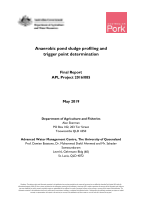Library & Resources
Library & Resources
Complete Research Reports
Item Details

Anaerobic pond sludge profiling and trigger point determination
141 Pages
Author(s): Dr Mohammad Shakil Ahmmed, Sahadev Somasundaram, Alan Skerman, Prof Damien Batstone
The accumulation of sludge in anaerobic effluent treatment ponds used at the majority of Australian piggeries has proved to be a difficult issue to manage effectively for several decades. The major objectives of this project were to address the factors that constrain producers from effectively managing sludge.
Sludge profiling was carried out by Premise Agriculture (formerly FSA Consulting) on eleven primary anaerobic ponds and four secondary effluent storage ponds operating at ten commercial piggeries located on the Darling Downs in southern Queensland.
The optimal pond design as determined by the model-based assessment is 150d HRT, which balances pond lifetime, capital cost, and performance. This will have a lifetime in the order of 3-5 years without in-situ desludging, assuming kinetics from methane potential tests. Lifetime will be longer based on the higher extent observed from the sampling campaign. A deep pond (6m+) is preferred to a shallow pond in order to (a) increase sludge holding capacity, (b) decrease the hydrodynamic impacts of sludge accumulation, (c) minimise internal recycles and bypass flows, and (d) enable in-situ desludging. Sloped sidewalls are important to minimise dead zones and allow the sludge to accumulate in a desludging zone. Desludging events should be at relatively long term intervals (100 days) to minimise the methane potential of the resulting product (and maximise the in-pond performance).
Download



